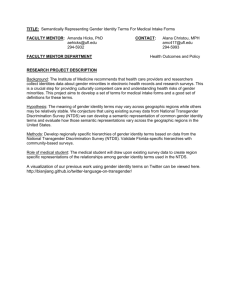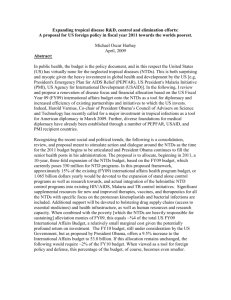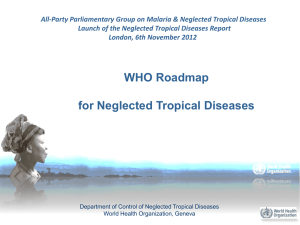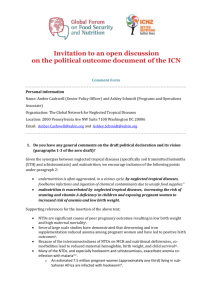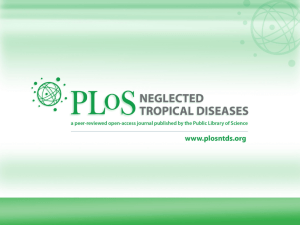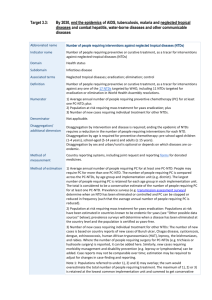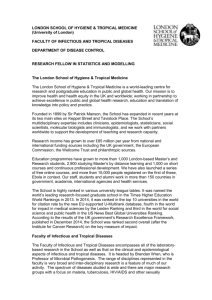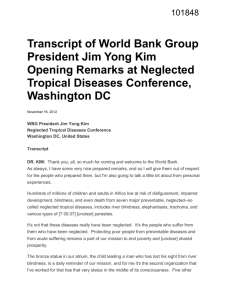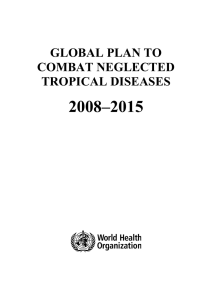Time to revisit Neglected Tropical Diseases in the
advertisement
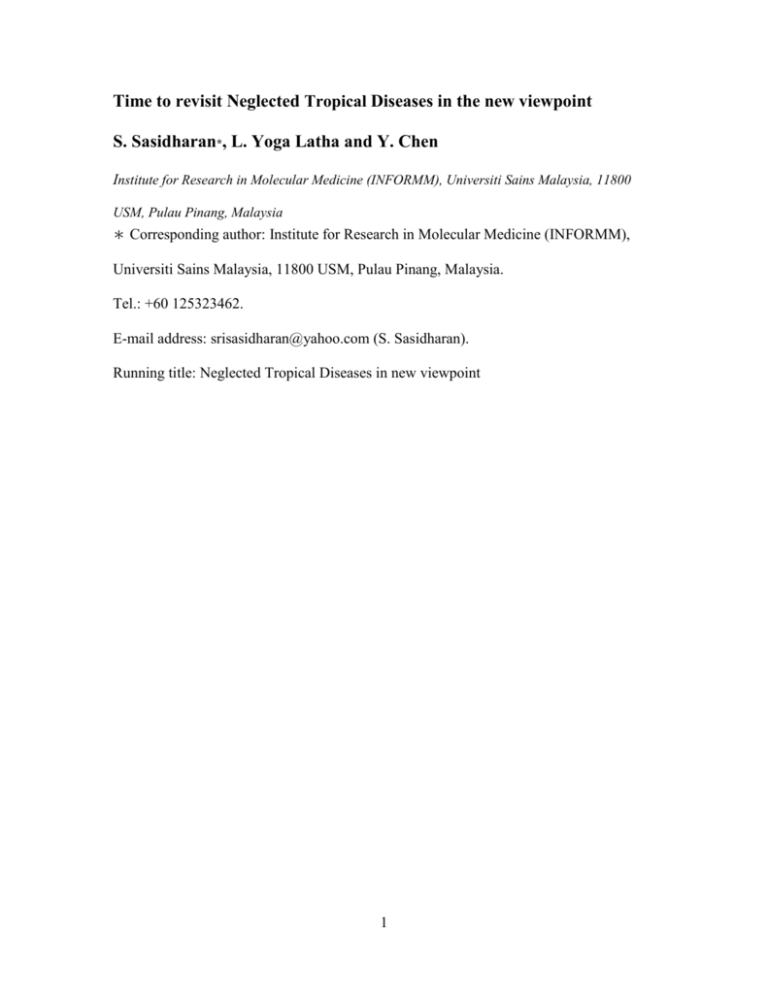
Time to revisit Neglected Tropical Diseases in the new viewpoint S. Sasidharan*, L. Yoga Latha and Y. Chen Institute for Research in Molecular Medicine (INFORMM), Universiti Sains Malaysia, 11800 USM, Pulau Pinang, Malaysia ∗ Corresponding author: Institute for Research in Molecular Medicine (INFORMM), Universiti Sains Malaysia, 11800 USM, Pulau Pinang, Malaysia. Tel.: +60 125323462. E-mail address: srisasidharan@yahoo.com (S. Sasidharan). Running title: Neglected Tropical Diseases in new viewpoint 1 Abstract It is improper for the world community to neglect certain diseases merely because the affected are the people from the poor countries, living in remote and rural areas. Here we review the importance of revisiting the tropical diseases, especially the neglected tropical diseases (NTDs) from a new perspective. The time has come for the international society to revisit the NTDs with a new perspective. These diseases affect the large amount of the world population, especially the bottom million societies. Hence, this scenario can no longer be overlooked. It is our responsibility to solve this crisis. This article also discuss the appropriate action should be taken by the world communities to solve this crisis for the benefit of the poor community. Keywords: Neglected tropical diseases; bottom million societies; Tropical medicine 2 Health is “a state of physical, mental and spiritual well-being, not merely an absence of disease or infirmity” (1). Health is a fundamental human right and crucial important factor that drives the world economic. International health plays a major role to the world peace and to a sustainable economic and social development of a country. Hence, it is important to maintain optimal human health. Globalization which increased the deep connections between individuals of many countries has increased the rapid spread of infectious diseases between individuals from different part of the world and this includes the spread of neglected tropical diseases (NTDs). It is improper for the world community to neglect certain diseases merely because the affected are the people from the poor countries, living in remote and rural areas. Thus, we would like to comment about the importance of revisiting the tropical diseases, especially the neglected tropical diseases from a new perspective. The neglected diseases are a group of tropical infections which are especially endemic in low-income populations in developing regions of the world such as Africa, Asia, and the Americas. NTDs are named neglected because these diseases mostly affected the poorest and the most marginalized communities, and have been largely eliminated elsewhere and thus are often forgotten (2). Lacking a strong political voice, people affected by these tropical diseases have a low profile and status in public health priorities and largely seen as non profitable to invest by the pharmaceutical manufacturers. More than 1 billion world populations (one sixth of the world's population) are affected by one or more NTDs primarily poor populations living in tropical and subtropical climates with low-income economies (2). Contaminated uncooked vegetables, contaminated water delivery systems, houseflies, overcrowding, 3 poor hygiene, sharing beds during childhood and unsafe water have been cited as an important risks for infections in the developing world. These diseases affect the large amount of the world population, especially the bottom million societies. Thus, this scenario can no longer be overlooked. As we represent the civilized society of this modern era, it is our responsibility to solve this crisis for the benefit of the poor community as conventional drugs are unaffordable for them and health facilities are also inaccessible. The participation of global community and intersectoral engagement can definitely be the strength to achieve the goal “health for all” in all countries, both rich and poor. The time has come for the international society to revisit the NTDs with a new perspective. Although, today there is greater achievement in the medical world but its does not necessarily translate into sustainable health improvements especially among the poor people in the third world country. Hence, the third world countries mainly affected by NTDs needs preventive, curative, and rehabilitative services which are easily accessible to individuals and families in the community and at a cost that the community and country can afford to maintain their health. Little is invested in developing treatment for these NTDs, just because doesn’t promise any great turnover to the pharmaceutical manufacturers and felt that NTDs concerns were not theirs. This mental attitude should change by the global community and pharmaceutical manufacturers. Individuals' altruism and responsibility in the implementation of world society's well-being should be cultivated for the benefit of mankind especially for the poorest communities where conventional drugs are unaffordable or unavailable. We are at a critical time in the development of affordable health systems for the poorest communities which will ensure 4 world peace and sustainable economic and social development. The current statuses in NTDs, with increasing demand, rising costs, and little investment, makes re-looking at of the NTDs timely and relevant. Hence, the international communities including government and non-governmental organisations have the duty to participate in the planning and implementation of affordable health systems to overcome NTDs related problems and to improve survival in the poorest countries but how to achieve these improvements remains a challenge. One of the major challenges is linking health and sustainable development. If we success to persuaded the missing linkages between health and sustainable development its will facilitate and encourage to increased the government spending in health and greater private sector involvement (3). This missing linkage in poor countries, such as Asian and African countries adversely affects the performance of health systems in terms of supply, with chronic underfunding of infrastructure and public health, reductions in the number and quality of health personnel, and worsening access to health care for the poor (4, 5). The fundamental research on neglected diseases always leads to new remedies to treat the diseases that affect the bottom million societies. However, this finding does not necessarily translate into the drugs and vaccines because this product has no market value due to the low buying power of the poor and marginalized population from the developing countries (6). Subsequently, this will be resulted a translational gap between research finding and health product development. We should appreciate the initiative taken by Merck and Company, the UK Wellcome Trust, world health organization (WHO), the United Nations Children’s Fund (UNICEF) and the Global Alliance for Vaccines and Immunisation (GAVI) on medical-research charity to bridge the 5 translational research gap that exists between research finding and health product development to create vaccines aimed at low-income countries (7). The time has come for the researchers to actively involve in translational research and the development of new drugs for NTDs. In order to be successful in bridging the translational research gap, four main conditions should be achieved. First and foremost, we must create a market for products in the poor developing country with the expected benefit for the pharmaceutical manufacturer. The next step will be to induce investment in R&D for neglected diseases and to encourage the collaboration between the local scientist and international research foundations as well as technology. Thirdly, the knowledge and technology should be transfered to local scientist to sustain the research activity. Finally, the product must bring a positive result to the consumer and for their welfare. Various push and pull mechanisms should be introduced to materialize these three conditions by subsidizing the research input and rewarding the research output. These strategies can ensure the research benefits to reach the poor communities. Funding: None. Conflicts of interest: None declared. Ethical approval: Not required. References 1. WHO. Preamble to the constitution of the World Health Organization International Health Conference, New York, 19–22 June, 1946. Geneva, Switzerland: World Health Organization, 1948. 2.WHO. 10 Facts: neglected http://www.who.int/neglected_diseases/en/index.html. 6 tropical diseases. 3. Anon. World development report 1993: investing in health. Washington, DC: World Bank, 1993. 4. Palmer N, Mueller DH, Gilson L, Mills A, Haines A. Health fi nancing to promote access in low income settings-how much do we know? Lancet 2004; 364: 1365–70. 5. Gilson L, McIntyre D. Removing user fees for primary care in Africa: the need for careful action. British Medical Journal 2005; 331: 762–65. 6. Butler D. Neglected Diseases Lost in translation. Nature 2007; 449: 158-159. 7. Butler D. Vaccine venture boosts health hopes. Nature 2009; 461: 323-323. 7
